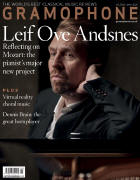Texte paru dans: / Appeared in: |
|
|
Outil de traduction (Très approximatif) |
|
|
Reviewer: Marc Rochester Vocal forces of just 10 singers supported by the same number of instrumentalists bring a level of intimacy that is entirely appropriate to this programme of 17th-century music reflecting on the Passion. Solo voices have a disarming purity and immediacy of expression about them, while the small instrumental forces are a perfect match in quality of sound and directness of expression. Buxtehude’s highly original and deeply moving series of mini-cantatas Membra Jesu nostri, contemplating the Crucifixion by reflecting on seven parts of Christ’s body – feet, knees, hands, side, breast, heart and face – takes on a particularly intense character in this performance, which may well get closer to the essential spirit of the work than those that give it a more lavish performance. In a footnote to Peter Wollny’s excellent booklet essay, Sébastien Daucé explains that he has produced his own arrangement from original sources housed in the Uppsala University library. There are some differences to the work as we usually hear it but the most noteworthy thing about this outstanding performance is the intensity and intimacy brought out by the members of Ensemble Correspondances under Daucé’s sensitive direction. That sense of intense intimacy is even more potent in the ‘Klag-Lied’ from Buxtehude’s Fried- und Freudenreiche Hinfahrt des alten grossgläubigen Simeons, written shortly after the death of his own father. This very private utterance is delivered with great delicacy by a solo alto voice, followed on this recording by the chorale sung with equal sensitivity by female and male voices in alternation. The recording closes with Buxtehude in an altogether more upbeat mode, yet still reflecting on the Passion. This is a brisk, buoyant performance of Herzlich Lieb hab ich dich, o Herr; and while the female voices have a beautiful flowing quality, the tendency to lean on dynamics to create mini-surges of volume is mildly irritating. Heinrich Schütz’s setting of the same chorale is an altogether more sober affair, set as a concerto with the instrumentalists providing a finely woven prelude to the chorale itself, which is voiced with great elegance by a solo soprano. Schütz’s Da Jesus an dem Kreuze stund is, after Membra Jesu nostri, the other major work recorded here. It is a setting of the Seven Last Words framed, palindromically, by two pairs of movements, a choral Introitus and Conclusio, and instrumental Symphonias. Again, the performance is notable for the transparency of texture and purity of sound, the polyphonic writing delivered with impressive clarity. Possibly unfamiliar will be the name of Lüdert Dijkman. He was a Swedish organist who wrote his only surviving work, Lamentum eller En Sorge-Music, following the deaths, in close succession, of two Swedish princes in infancy. The opening Aria is given to a soprano solo, which here gives it an appropriately childlike quality, and a very brief section for male voices leads into a straightforward chorale-like aria which, for all its lack of complexity, is exquisitely performed by this outstanding instrumental and vocal ensemble.
|
|




